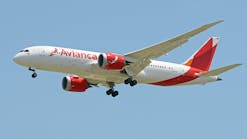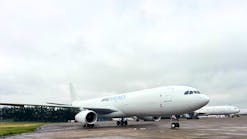Cover Story
Pellston’s Pride
When visitors arrive at PLN, they know they’re in the northwoods
By Jodi Richards
November/December 2004
PELLSTON, MI — Travelers driving through this small (populationsome 550), rustic resort town, 25 miles south of Mackinac Island, mightnot be surprised to see a cedar lodge. However, to realize it’snot a resort but an airport can be quite a shock. According to airportmanager Kelley Atkins, people often visit the airport just to see what it’s like on the inside. The airport, with the strong support of the community, has been successful in attracting passengers while capturing the feel of the Michigan northwoods.
Pellston Regional manager Kelley Atkins in front of one of three fireplaces in the Northern Michigan terminal.
Pellston Regional Airport (PLN) is owned by Emmet County. Operations are overseen by an airport committee comprised of three county commissioners and three appointed members. Atkins explains there is also an air service task force to assist with air carrier retention and recruitment.
The county not only operates the airport, but also provides services of fixed base operator and handles all ground handling. UNICOM and ARFF services, as well as cleaning of both the terminal and aerocenter (general aviation building) are contracted out locally.
The growth of the airport and the recent redevelopment of the terminal, completed one year ago, can be attributed to the support of the community, says Atkins, who was named Michigan Airport Manager of the Year in 2003 by the Michigan Association of Airport Executives. “With the county and the airport committee, there’s consensus support for the airport. We wouldn’t have been able to accomplish these things if the county hadn’t been 100 percent behind it.
“This board really realizes the importance of an airport to the community. It’s not a constant battle that I have to keep fighting.”
Craig Sincock, president and CEO, Avfuel, which provides the airport’s fuel, agrees with Atkins. “The entire airport board understands that an airport is an integral part of a community. They had the vision and executed what was needed to match the resort and regional growth with the growth of the airport.”
The lodge-themed terminal started as an $80,000 bathroom renovation, says Atkins. “We got into that and started looking at things we wanted to see in the airport and the project started to grow. The county really wanted to adopt a theme, and that theme was a Northern Michigan style lodge.”
The project was by no means merely aesthetic. The aging terminal was in need of updates and the community recognized the need for a larger facility to handle growing traffic. “Every community wants to upgrade their service,” says Atkins. “The community decided rather than sit on our hands, let’s really go and take the next few years and make ourselves better prepared and do everything we can to attract new service. Out of that, this building was born.”
Madison, WI-based Mead & Hunt was the engineering firm on the project, while locally based Town & County Cedar Homes provided the log work, and Quiet Moose Interiors handled the extra touches for the lodge ambiance. Atkins explains, “We did not want the basic municipal building that could double as a junior high school or bus station.”
From the three fireplaces on two floors, log work, mounted wildlife to the light fixtures, bathroom mirrors, furniture, and signage, nothing was overlooked in making this terminal feel like a true lodge.
The new terminal also includes a gift shop, two car rental companies, two shuttle companies, as well as the Village Inn Restaurant, which has locations on Mackinac Island and in St. Ignace, MI.
PLN received $7 million in discretionary funds from FAA over two years. The total cost of the terminal redevelopment is some $8.4 million.
Growing Demand, Service
PLN is currently serviced by Northwest Airlines’ regional carriers
Mesaba and Pinnacle airlines. Atkins says service is good, but “obviously
we’d like to someday see a second carrier.”
The airport’s passenger numbers have been steadily increasing over
the last two years, says Atkins. “We’re growing at a rate that
astounds us.”
Through August 2004, enplanements are up 25 percent over the same period in 2003. PLN averages some 65,000 passengers annually.
Along with the redevelopment of the terminal came the commitment by Northwest for more seats. Additionally, says Atkins, “Three years ago we saw the return to jet service for the first time in 25 years, with just one a day. The next year it jumped up to three a day, and this last year weekdays in the peak season (June, July, and August) it was five a day and seven a day on the weekends.”
Because of the seasonality of Northern Michigan, the number of flights to and from Pellston changes almost quarterly. However, Atkins adds, “We’re managing to keep at least one RJ in service on a daily basis throughout the year.”
According to Atkins, Chicago is a market to which the airport would like service. “We attract a good number of people from Chicago, but getting a carrier to commit would be difficult because of the seasonality of our location. Carriers are having a tough time and not taking a lot of gambles. That’s what makes Northwest’s service increase promising.”
He adds that the region is seeing more tourism in the non-traditional months, which adds to the possibility of more service and/or an additional carrier. “Now that our numbers are growing, I feel that in the near future we will be able to viably support two airlines on a year-round basis.”
Atkins and the airport board have worked “aggressively” with Northwest to keep airfares competitive with surrounding airports. “We hope that if we’re close on ticket price, and with the free parking and the facility we’ve got, that will attract more passengers.”
Looking ahead, Atkins says a concern is parking. “We’ve had cars parked during the spring break season lined three deep into the grass.” A current ongoing project, expected to be completed mid-November, is the expansion of the ramp, at a cost of $1.8 million, necessary because of increased traffic.
The “overwhelming majority” of the airport’s revenue comes from fuel sales, says Atkins. Currently, fuel sales average around 375,000 gallons of jet fuel per year and some 70,000 gallons 100LL. “I think we’ve seen a drop in the 100LL this last year, but I think that’s industry-wide,” says Atkins. “Jet fuel, we’re ahead of the pace we set last year.” Landing fees and rent from 26 hangars contribute as well.











